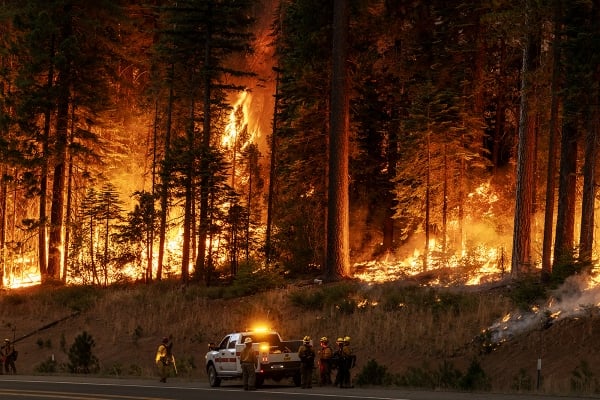The undying Park Fire spreading through Northern California started about 10 miles from the campus of California State University, Chico. While the wildfire has so far spared Chico State’s main campus, it’s already displaced numerous employees from their homes and destroyed most of the university’s 7,835-acre Big Chico Creek Ecological Reserve.
The fire, which experts say has been exacerbated by exceedingly hot summer temperatures, is a searing reminder to Chico State and the rest of the 23-campus California State University system about why CSU is backing numerous initiatives to promote sustainability, mitigate the effects of climate change and educate climate-anxious students about how to forge solutions.
“Our students are demanding we pay attention to climate change,” said Mildred García, system chancellor. “Our institutions already serve as crucial community anchors, and we need to leverage our resources and influence to build resilience for our communities.”
What Can Higher Ed Do About Climate Change?
Helping other colleges and universities lead on climate action—through research, workforce development, operations management, public policy advocacy and community engagement—is why García co-chaired the Aspen Institute’s Higher Ed Climate Task Force, composed of 20 members with expertise in climate, education, philanthropy and business.
In collaboration with This Is Planet Ed, an initiative of the Aspen Institute’s energy and environment program, the task force recently published its Higher Ed Climate Action Plan, which provides colleges and universities a blueprint for advancing climate action that will benefit both campuses and the larger communities they serve.
“The effects of climate change are harming people and communities across our country and the globe. These effects will only worsen in the decades to come,” the report said. “There is a critical opportunity for higher education to leverage its strengths to build knowledge, foster innovation, enhance communities, and model solutions to help build a sustainable, resilient and just world.”
Some of the report’s recommendations include prioritizing climate literacy and solutions-focused community engagement, developing and communicating actionable research, and equitably distributing the benefits of climate initiatives.
Unlocking Higher Education’s Power to Address Climate Change
Colleges and universities are uniquely positioned to tackle climate change with a multipronged approach, according to a new report from the Aspen Institute. The Higher Ed Climate Action Plan includes the following recommendations for colleges and universities:
- Engage students in learning about climate change and solutions.
- Support necessary student services outside the classroom, from basic needs to mental health to aiding student success in a changing climate. This includes helping establish pathways to clean-economy jobs.
- Leverage town-gown relationships to support broader action on climate change, including engaging students, families and community members in their languages and spaces.
- Model, research and develop climate mitigation and adaptation solutions that reduce carbon pollution, build resilience to potential risks and foster innovation.
- Ensure equal opportunity for all students, institutions and communities to benefit from a more sustainable, resilient and equitable society.
While the higher education sector is uniquely positioned to both educate new generations and build on expand existing knowledge about climate science, it’s also emerging as a model for making an industry’s physical operations more environmentally sustainable.
“The education sector has a huge physical footprint, so the ability for it to impact net-zero carbon emissions goals is tremendous,” said John B. King, Jr., chancellor of the State University of New York system and former U.S. secretary of education, who co-chairs This Is Planet Ed. “But we also have this critical educational goal of preparing students for a world transformed by climate change across all disciplines.”
SUNY hired its first chief sustainability officers in 2023 to lead the development of a systemwide climate action and sustainability plan that integrates workforce development, research and academic programming. Some plan highlights: renovating campus buildings to become more energy efficient, transitioning toward zero-emission vehicles and establishing the Offshore Wind Training Institute and other workforce training programs related to renewable energy, HVAC, electric vehicles and charging, water, and wastewater maintenance and construction.
Joanne Mahoney, president of SUNY’s College of Environmental Science and Forestry, said there’s an urgent need for colleges and universities across the country to formulate climate action plans that share similar goals, which is where something like the Aspen Institute’s new report comes in.
“We have to have conversations among the 4,000 institutions of higher ed so we can go faster,” she said. “We’ve lost time debating the science of climate change for the last several years, and that was very valuable time that we can make up by working together now.”
Despite the overwhelming scientific consensus that Earth is warming as a result of centuries of industrialization, a relatively small portion of colleges and universities have prioritized sustainability programming.
The SUNY system is one of about 371 institutions in the U.S. staffed with sustainability professionals, such as a sustainability director or coordinator, according to a 2023 survey from the Association for the Advancement of Sustainability in Higher Education (AASHE).
Additionally, some 300 institutions hold a valid rating through the association’s Sustainability Tracking, Assessment & Rating System (STARS), which is a self-reporting framework designed to help colleges and universities to measure their sustainability performance. Institutions are scored on how they address sustainability through curriculum, research, community and campus engagement, and physical operations.
Much like the Aspen Institute’s new guidance, STARS is “an agenda for every single department on campus to recognize that there’s a role for everyone in the campus community to play as it relates to sustainability,” Meghan Fay Zahniser, executive director of AASHE, said. “Knowing that the experiences of students and their mental health is becoming increasingly fragile, we’re trying to get people to focus on action.”
Climate Anxiety
A 2021 study published in The Lancet found that of 10,000 16- to 25-year-olds surveyed, 59 percent were “very or extremely worried” about climate change, and 84 percent were at least “moderately worried.” More than half felt “sad, anxious, angry, powerless, helpless, and guilty.”
That’s something Mark Stemen, an environmental studies professor at Chico State, has spent the last few years trying to correct.
“The way we teach about climate change is making their anxiety worse,” he said of students. “They’ve been hearing about climate change since they were born. They don’t want to hear about the problem anymore. They want to hear about solutions.”
This became glaring to Stemen after the devastating Camp Fire shut down the campus for three weeks back in 2018.
“When we came back, students started talking about it and asking questions about it, and it wasn’t just in their science classes. It was in their philosophy classes, art classes and engineering classes,” Stemen recalled. “The students came together and said they wanted to see climate change taught more, but in all fields of studies.”
Soon after, students passed a resolution demanding as much.
With the university administration’s backing, Stemen organized a workshop to help faculty reframe their courses to include relevant discussions of climate change. That workshop was so popular that Stemen has since spearheaded the launch of the Faculty Learning Community in Teaching Climate Change and Resilience, which has helped professors at 21 CSUs and three California Community College campuses redesign hundreds of courses across 54 disciplines, including political science, art and business.
And when students return to campus later this month looking for reassurance about their futures in the wake of the Park Fire, the climate-focused curriculum redesign—along with Chico State’s suite of other sustainability initiatives—will help professors guide those anxious conversations toward solutions.
“In truth, our campus’s carbon footprint isn’t that big compared to the other institutions in our town. But our educational footprint is the size of another state,” Stemen said, noting the exponential influence university researchers and graduates have in shaping climate science conversations. “Higher education institutions have the ability to spread this news and education unlike anybody else.”




















Discussion about this post